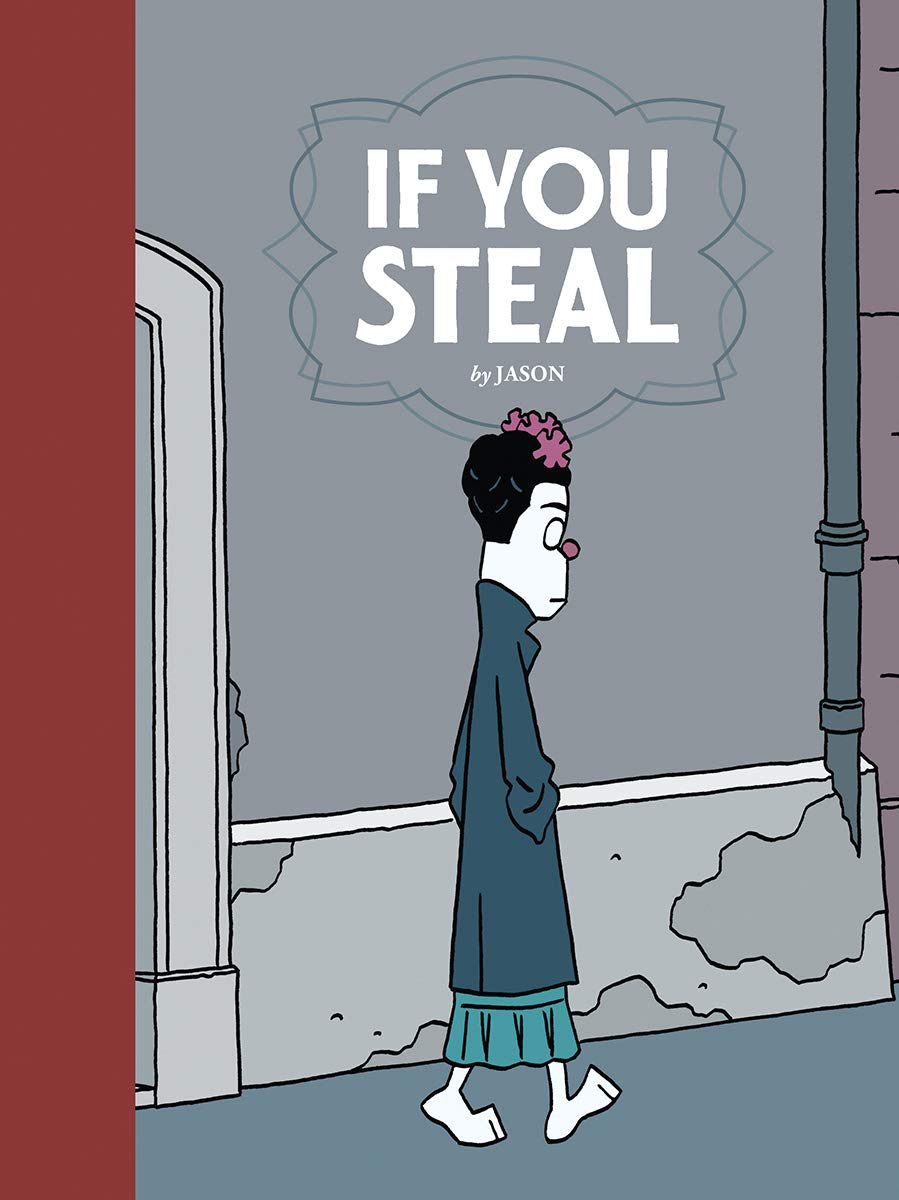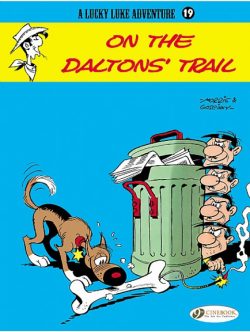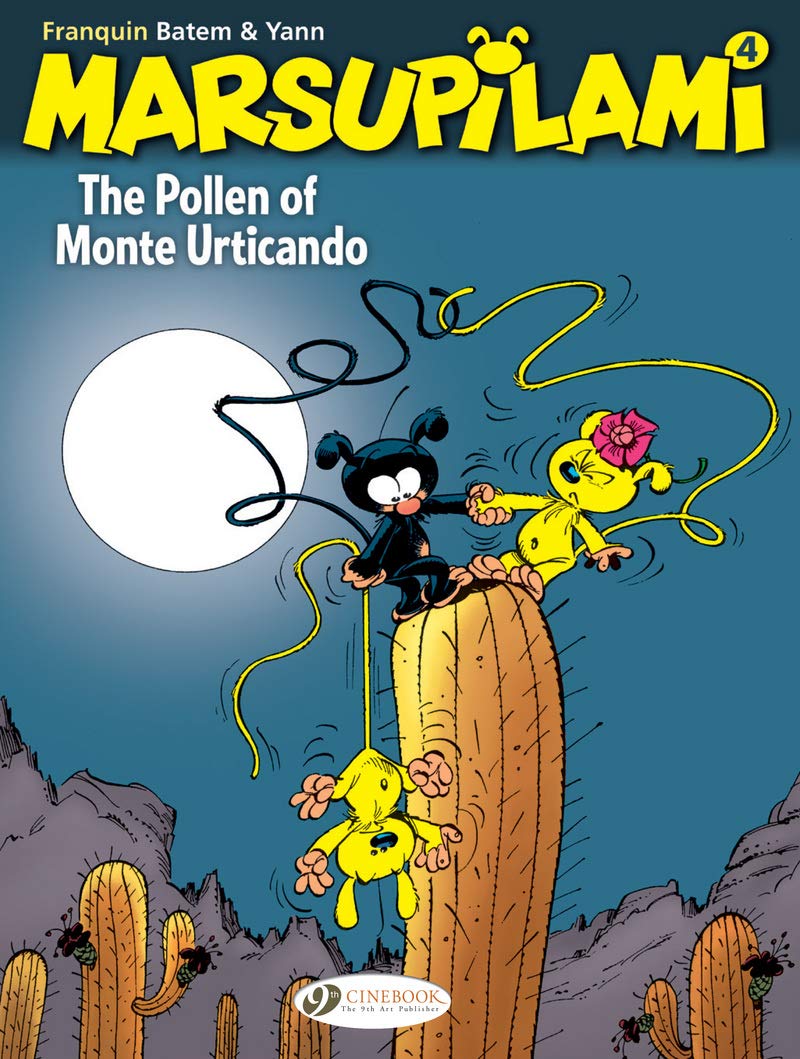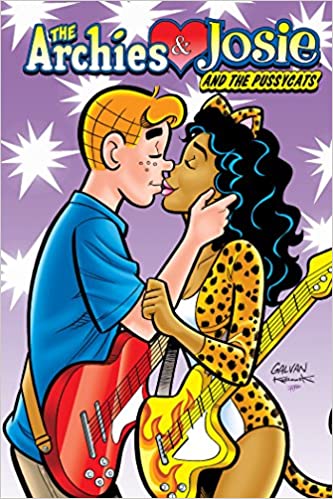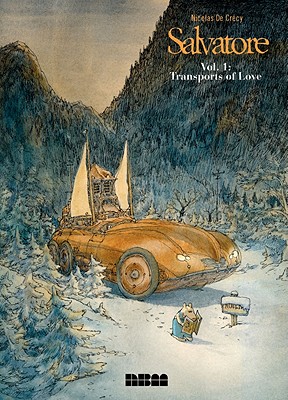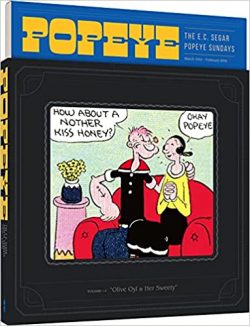
By Franquin, Batem & Yann; coloured by Cerise and translated by Jerome Saincantin (Cinebook)
ISBN: 978-1-84918-542-4 (Album PB/Digital edition)
One of Europe’s most popular comic stars is an eccentrically irascible, loyally unpredictable, super-strong, rubber-limbed ball of explosive energy with a seemingly infinite elastic tail. The frantic, frenetic Marsupilami is a wonder of nature and icon of European entertainment invention who originally spun-off from another immortal comedy adventure strip…
In 1946 Joseph “Jijé†Gillain was crafting eponymous keystone strip Spirou for flagship publication Le Journal de Spirou when he abruptly handed off the entire kit and caboodle to his assistant Franquin. The apprentice took the reins, slowly abandoned a previous format of short complete gags to pioneer longer adventure serials, and began introducing a wide and engaging cast of new characters.
For 1952’s Spirou et les héritiers, he devised a beguiling and boisterous South American critter and tossed him like an elastic-arsed grenade into the mix. Thereafter – until his resignation in 1969 – Franquin frequently included the bombastic little beast in Spirou’s increasingly fantastic escapades …
The Marsupilami returned over and over again: a phenomenally popular magical animal who inevitably grew into a solo star of screen, toy store, console games and albums all his own.
André Franquin was born on January 3rd 1924 in Etterbeek, Belgium. Somewhat a prodigy, he began formal art training at École Saint-Luc in 1943, but when the war forced the school’s closure a year later, he found animation work at Compagnie Belge d’Animation in Brussels. Here he met Maurice de Bevere (Lucky Luke‘s creator Morris), Pierre Culliford (Peyo, creator of The Smurfs) and Eddy Paape (Valhardi, Luc Orient).
In 1945, all but Culliford signed on with publishing house Dupuis, and Franquin began a career as a jobbing cartoonist and illustrator, drawing covers for Le Moustique and scouting magazine Plein Jeu. During those formative days, Franquin and Morris were being trained by Jijé – at that time the main illustrator at Le Journal de Spirou. He quickly turned the youngsters – and fellow neophyte Willy Maltaite (AKA Will: writer/artist of Tif et Tondu, Isabelle, The Garden of Desire and much more) – into a potent creative bullpen dubbed La bande des quatre; or “Gang of Fourâ€. They subsequently revolutionised Belgian comics with their prolific and engaging “Marcinelle school†style of graphic storytelling.
Jijé handed Franquin all responsibilities for the flagship strip part-way through a storyline (Spirou et la maison préfabriquée, in Le Journal de Spirou #427, June 20th 1946). The eager novice ran with it and carried on with Spirou for two decades, enlarging the scope and horizons until the feature became purely his own.
Every week, fans would meet startling and zany new characters like comrade eventual co-star Fantasio or crackpot inventor Count of Champignac, and ultimately Spirou et Fantasio became globe-trotting journalists, “reporting back†their exploits in unbroken four-colour glory for and in Le Journal de Spirou…
In a splendid example of good practise, Franquin mentored his own band of apprentice cartoonists during the 1950s. These included Jean Roba (La Ribambelle, Boule et Bill/Billy and Buddy); Jidéhem (Sophie, Starter, Gaston Lagaffe/Gomer Goof) and Greg (Bruno Brazil, Bernard Prince, Achille Talon, Zig et Puce), who all worked with him during his tenure on Spirou et Fantasio.
In 1955 a contractual spat with Dupuis resulted in Franquin signing up with publishing rivals Casterman on Le Journal de Tintin, collaborating with René Goscinny and old pal Peyo whilst creating the raucous gag strip Modeste et Pompon.
Franquin and Dupuis patched things up within days, and he went back to Le Journal de Spirou. In 1957, he co-created Gaston Lagaffe, but was still legally obliged to carry on his Tintin strip work too. From 1959, writer Greg and background artist Jidéhem assisted Franquin, but a decade later the artist had reached his Spirou limit and in 1969 resigned for good, taking his mystic yellow monkey with him…
Plagued by bouts of depression, Franquin passed away on January 5th 1997, but his legacy remains: a vast body of work that reshaped the landscape of European comics. Moreover, having learned his lessons about publishers, Franquin retained all rights to Marsupilami and in the late 1980’s began publishing his own adventures of the rambunctious miracle-worker.
He tapped old comrade Greg as scripter and invited commercial artist/illustrator Luc Collin (pen-name Batem) to collaborate on – and later monopolise – the art duties for a new series of raucous comedy adventures. In recent years, the commercial world has triumphed again and since 2016 the universes of Marsupilami and Spirou have again collided allowing the old firm to act out in shared stories again…
Blessed with a talent for mischief, the Marsupilami is a deviously adaptive anthropoid inhabiting the rain forests of Palombia and regarded as one of the rarest animals on Earth. It speaks a language uniquely its own and also has a reputation for causing trouble and instigating chaos. The species is rare and is fanatically dedicated to its young. Sometimes that takes the form of “tough loveâ€â€¦
Baby Prinz was released in 1989, fifth of 32 albums (not including all-Franquin short-story collection volume #0, AKA Capturez un Marsupilami): a canny fable on the dangers of power which opens in Palombian capital city Chiquito, where zookeepers examine an all but forgotten exhibit. This Marsupilami has been caged for decades – nobody knows quite how many – and seems to by dying. The event has deeply agitated all the other animals, and during the fuss a macaw escapes, heading straight for the dark heart of the dense rainforest…
Soon, it finds jungle-dwelling white kids Bip and Sarah, who have been raising themselves in the green hell – with a little oversight from the Marsupilami patriarch. The bird carries a desperate request: the zoo “Marsu†is willing himself to die but the macaw believes a quick intervention from a fresh, wild cousin might give his oldest friend a reason to go on…
The bird has it all figured out. There’s a festival looming and all Chiquito is gearing up for fancy dress larks as the nation celebrates the anniversary of the coup that first brought Papa Prinz to tyrannical power. He’s been dead for years now and his son Baby Prinz is in charge but has to publicly appear to give a speech. It’s a tradition.
Everyone is very excited. Baby Prinz is seldom seen after surviving 12 annual coup attempts and assassinations. His Papa managed 27 before finally being killed by revolutionaries, and the people know that when Baby ceremonially appears again, they can have another go at the little dictator. It’s also tradition…
As festivities escalate, secret police are everywhere: spying on gatherings of one or more people and anticipating trouble on every side. The oppressed and very drunk citizens carry on regardless, gleefully aware of the covert Seguridad cops’ big blunder. Each spy/thug wears exactly the same Marsupilami costume…so they can recognize each other in the crowds…
There is one snag, however. Spoiled, despotic fop Baby Prinz has reached his emotional limit. His nerve has gone. He cannot face making a balcony speech to the foul, unwashed rabble who are literally beneath him.. and probably all concealing a weapon to kill him with. He just wants to curl up in his sensory deprivation tank with his collection of plush animal toys, but his overbearing and bullying major domo/butler/father’s best friend won’t let him…
Just one appearance is enough. The crowds confirm that their tyrant is not a “real man†and their shouts convince the army (the usual suspects and beneficiaries of every Palombian revolution) pick sides and start the process all over again…
As his guardian leads Baby Prinz to safety through long-disused escape tunnels, the rioting people are briefly halted by the rumour of deadly mechanised secret weapons. These mobile landmines are also disguised as Marsupilamis, and the entire revolution is being screened live by television cameramen even more ferocious than the rioters…
All this time the jungle kids, macaw and true Marsupilami have been heading towards the largely abandoned zoo, where the keeper and his wife are drinking and viewing all the excitement from the comfort of his office. The former government employees’ position of safely distanced neutral observance vanishes as the Baby and his major domo exit the escape tunnel under the lion enclosure (formerly the far-safer sloth cage), leaving the big cats their own way out via the tunnel back to the palace.
Safely stashing the fed-up, brain-shocked dictator in another cage, his bad but loyal butler goes looking for hidden passports, unaware that his useless boss has piqued the waning attention of an astoundingly ancient inmate… particularly the froufrou designer handbag with all the designer recreational pharmaceuticals in it…
As latest opportunist Aquileo Zavatas declares himself the new boss, the jungle-based rescue party’s progress is briefly halted when rioters attempt to remove Marsupilami’s “disguise†and discover to their eternal regret that there are worse things in life than a cop in a monkey suit… especially after the furious furry (called by Polombians “El diabloâ€, and “La catástrofe amarillaâ€) is trapped inside a tank carrying live rounds and more than lives up to his hype…
Joined by his friends, they continues causing chaos in the streets, even as the old Marsu revives and proceeds to enact his new last wish: travelling to the fabled Marsupilami’s grave yard to end his days among his own kind. Typically, the leechlike Baby Prinz has attached himself to the old beast and the macaw and goes with them…
Ending with astute political comics commentary and a fantastic twist of fate, this tale is a superbly savvy comparison of duty, family values and the power of corruption, but don’t worry about all that because it’s also another masterfully madcap rollercoaster of hairsbreadth escapes, close shaves and sardonic character assassinations, packed to the whiskers with wit and hilarity.
These eccentric exploits of the garrulous golden monkeys are moodily macabre, furiously funny and pithily pertinent, offering engagingly riotous romps and devastating debacles for wide-eyed kids of every age all over the world. Fancy channelling your inner El diablo and joining in the fun? It all stars with Hoobee, Hoobah Hoobah…
© Dupuis, Dargaud-Lombard s.a. 1990 by Franquin, Yann & Batem. English translation © 2020 Cinebook Ltd.
